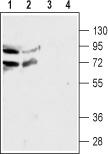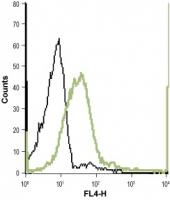Nicotinic Acetylcholine Receptor alpha 4 (CHRNA4) Rabbit Polyclonal Antibody
CAT#: TA328607
Rabbit Polyclonal Anti-Nicotinic Acetylcholine Receptor alpha 4 (extracellular
Need it in bulk or conjugated?
Get a free quote
CNY 11,000.00
CNY 300.00
CNY 1,430.00
CNY 2,900.00
CNY 9,998.00
Specifications
| Product Data | |
| Applications | FC, IHC, WB |
| Recommend Dilution | WB: 1:200-1:2000; IHC: 1:100-1:3,000; FC: 1:50-1:600 |
| Reactivity | Human, Mouse, Rat |
| Host | Rabbit |
| Clonality | Polyclonal |
| Immunogen | Peptide (C)DLVNMHSRVDQLD, corresponding to amino acid residues 190-202 of human nAChRa4. Extracellular, N-terminus. |
| Formulation | Lyophilized. Concentration before lyophilization ~0.8mg/ml (lot dependent, please refer to CoA along with shipment for actual concentration). Buffer before lyophilization: Phosphate buffered saline (PBS), pH 7.4, 1% BSA, 0.025% NaN3. |
| Reconstitution Method | Add 50 ul double distilled water (DDW) to the lyophilized powder. |
| Purification | Affinity purified on immobilized antigen. |
| Conjugation | Unconjugated |
| Storage Condition | Store at -20°C as received. |
| Gene Name | cholinergic receptor nicotinic alpha 4 subunit |
| Database Link | |
| Background | Acetylcholine, released by cholinergic neurons, activates two groups of acetylcholine receptors (AChRs); muscarinic AChRs (mAChRs) which belong to the superfamily of G-protein coupled receptors (GPCRs) and nicotinic AChRs (nAChRs) which belong to the ligand-gated ion channel superfamily. nAChRs also respond to nicotine, hence their name. These channel receptors are usually non-selective cation channels activated upon ligand binding which ultimately leads to the depolarization of postsynaptic cell membranes. To date, 17 different but related subunits of nAChRs have been identified and cloned. They consist of a subunits (a1-10), which is responsible for the binding of ligands. In fact, this subunit includes a Cys-loop in the first extracellular domain that is required for agonist binding. The other subunits responsible for making up the active receptor are the Ã? (Ã?1-4), ?, d and e subunits. Structurally, all subunits have the following: a conserved large extracellular N-terminal domain, 3 conserved transmembrane domains, a variable cytoplasmic loop and a fourth transmembrane domain with a short extracellular C-terminal domain. An active nAChR is generally a heteropentamer (homopentamers also exist) of these various subunits organized around a central pore. All a subunits are expressed in neuronal cells except for the a1 subunit which is specifically expressed in skeletal muscle. They are also expressed in non-neuronal cells such as bronchial epithelial cells, as well lymphocytes. The diversity of these receptors and their functional organization gives rise to unique properties and functions. The a4Ã?2 receptor composition makes up a high affinity nicotinic receptor. In fact, its upregulation (mainly expressed by the increase of functional receptors at the membrane and not expression per se) is responsible for the increased appearance of binding sites following nicotine administration. Animal studies have shown that nAChR-related mechanisms are involved in attention function. Indeed a4Ã?2 nAChR seems to also be involved in attention-deficit hyperactivity disorder (ADHD), a disease distinguished by a lack of attention, distractibility and hyperactivity. The a4Ã?2 and a7 nAChRs appear to be critical in rats for attention and working memory. Also, a a4Ã?2 specific agonist was shown to reduce impulsivity, hyperactivity and attention deficits in adults with ADHD. This same receptor subtype may also be involved in Parkinsonâ??s disease (PD) as smoking and a4Ã?2 nAChR agonists show beneficial effects in PD. |
| Synonyms | BFNC; EBN; EBN1; NACHR; NACHRA4; NACRA4 |
| Reference Data | |
| Protein Families | Druggable Genome, Ion Channels: Cys-loop Receptors, Transmembrane |
Documents
| Product Manuals |
| FAQs |
| SDS |
Resources
| 抗体相关资料 |
其它Nicotinic Acetylcholine Receptor alpha 4产品


 United States
United States
 Germany
Germany
 Japan
Japan
 United Kingdom
United Kingdom
 China
China



